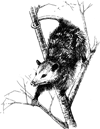Vertebrate Pest Conference: Proceedings

Vertebrate Pest Conference Proceedings: 16th (1994)
Date of this Version
February 1994
Document Type
Article
Abstract
The Levant vole, Microtus guentheri, is a pest of most of the field crops in Israel. It lives in gallery systems, the openings of which are clearly visible, and is active above ground mainly at night. Its activity was assessed by plugging the burrow openings (holes) and, after three nights, counting the number of reopened holes. The efficacy of control by whole wheat toxic baits was determined by counting the number of reopened holes before and after the treatment in random squares. Three chemicals were tested: sodium fluoroacetate, zinc phosphide and brodifacoum. The bait was applied either by hand, airplane, or centrifugal spreader. The period between treatment and post-treatment count was one week for the two acute rodenticides, and at least two weeks for the anticoagulant baits. Satisfactory results were obtained: 1) by a 2% zinc phosphide bait, with 0.7 g inserted manually into the voles' holes, or distributed at rates between 4.2 to 12.2 kg/ha; 2) by a 0.05% sodium fluoroacetate bait, with 0.2 g being inserted manually into the holes, or distributed at rates of 1.6 to 4.0 kg/ha; and 3) by 0.005% brodifacoum bait, with 3 g being inserted manually into the burrows, or broadcast at rates of 5.8 and 8.7 kg/ha.

